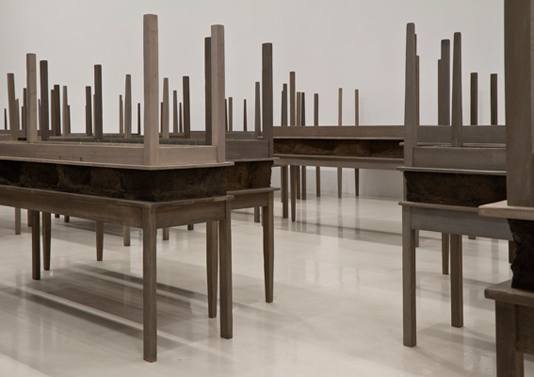
Exhibition view: Doris Salcedo: Plegaria Muda, Moderna Museet Malmö, 21 May–4 September 2011 © Doris Salcedo. Photo: Terje Östling
Doris Salcedo
Plegaria Muda
21.5 2011 – 4.9 2011
Malmö
Like few others, Doris Salcedo has given feelings of traumatic loss and suppressed sorrow a visual language and her work has engaged people all over the world. A pair of shoes from a missing person, or ordinary household furniture – such as a chair, a table or a bed – have, by her hand, been transformed into alternative memorials, impregnated with emotions of painful absence, while encapsulating a traumatic loss of human life.
In recent years Doris Salcedo has been increasingly noted for her large-scale installations and architectural interventions. In 2007, her work Shibboleth – a 167-metre-long crack in the floor of Tate Modern – stunned both museum visitors and the entire international art scene, while raising questions of borders, racial hatred and exclusion.
Although intimately entwined with the conflictual history of her native country, Colombia, the work of Doris Salcedo is based on thorough investigations of human conflict as manifested in different parts of the world and at different times in history. In a language that is subtle and poetic, yet of shattering power, she explores violence as a universal phenomenon and creates physical manifestations of the unspeakable wounds that it leaves behind.
The exhibition at Moderna Museet Malmö contains multiple references, and as an installation Plegaria Muda can evoke associations of a memorial or a collective burial site. It springs out of a three-year-long research of the ghettoes of South East Los Angeles, but is also a direct answer to repeated atrocities committed by groupings within the Colombian army between 2003 and 2009. Snared with false promises of job offers, some 1,500 young men, from poor and marginalised neighbourhoods, were in these years murdered, dressed up in rebel uniforms and falsely presented as guerrillas or paramilitaries killed in combat. As “false positives” these slaughtered young men allowed for units to fabricate results, and for officers to claim the financial rewards offered by the government for killed guerrillas.
Plegaria Muda may be translated as “Mute Prayer” and even though the piece responds to acts of violence, it imbues us with its contemplative stillness. It does not tell stories of individual victims, but in silence it gives voice to a collective trauma that has caused festering wounds throughout an entire social fabric. Removed from a private, anonymous invisibility to the very centre of this piece is a repressed and unprocessed sorrow – a sorrow that can find no place where violent death has been reduced to complete insignificance.
Curated by Joa Ljungberg, Curator at Moderna Museet Malmö and Isabel Carlos, Director of CAM-Fundação Calouste Gulbenkian and Lead Curator for the tour of Plegaria Muda.
The exhibition Plegaria Muda is commissioned by Moderna Museet Malmö and CAM-Fundação Calouste Gulbenkian in Portugal and has been produced in close partnership with MUAC – Museo Universitario Arte Contemporáneo, Mexico City; MAXXI – Museo nazionale delle arti del XXI secolo, Rome, and Pinacoteca do Estado de São Paulo.
The exhibition is supported by



